Brass band
A brass band is a musical ensemble generally consisting entirely of brass instruments, most often with a percussion section. Ensembles that include brass and woodwind instruments can in certain traditions also be termed brass bands (particularly in the context of New Orleans–style brass bands), but may more correctly termed military bands, concert bands, or "brass and reed" bands.
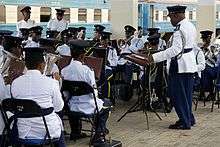
Styles
Balkan
Balkan-style Brass Bands (Serbian: Труба, trumpet) play a distinctive style of music originating in 19th century Balkans when Roma trumpeters influenced by Turkish marching bands transposed folk music into brass.[1] It is popular throughout the Balkans, especially Serbia, Albania, North Macedonia, Romania, Bulgaria and Northern Greece. The beats are usually fast and accompanied by kolo. The performers each have their instrument of the orchestra and are called trubači (трубачи). The best known examples of acclaimed music in this style are from Goran Bregović and Boban Marković Orkestar. The Serbian film maker Emir Kusturica has, through his films (Black Cat, White Cat), made the style popular in the international community outside the Balkans.
British-style
A brass band in the British tradition with a full complement of 28 players[2] (including percussion) consists of:
- 1 Soprano cornet in E♭
- 9 Cornets in B♭ (in separate parts for 'solo', 'repiano', 2nd and 3rd cornets; there are 4 players on the 'solo' part, one repiano, two 2nd, and two 3rd)
- 1 Flugel horn in B♭ (notated on the same part as the 'repiano' in some older music)
- 3 Tenor horns in E♭ (called solo, 1st and 2nd)
- 2 Baritone horns in B♭ (each with separate parts)
- 2 Tenor trombones (notated in B♭, playing separate parts)
- 1 Bass trombone (the only brass instrument in the band notated in Concert Pitch (C) on bass clef)
- 2 Euphoniums in B♭ (usually playing the same part with divisi sections)
- 4 Tubas (2 in E♭ and 2 in B♭, both notated in treble clef; often called Basses)
- 2 or 3 percussion players (with 2 or more timpani, glockenspiel, snare drum, triangle, cymbals, a drum kit and more)
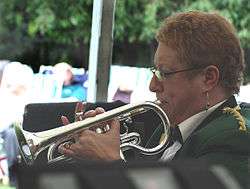
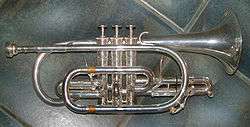

 Tenor Horn
Tenor Horn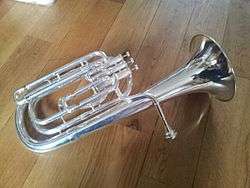
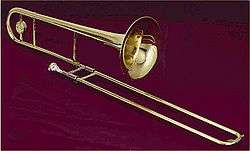 Tenor trombone
Tenor trombone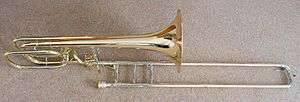 Bass trombone
Bass trombone
With the exception of the trombones, all of the brass are conical-bore instruments, which gives the British-style brass band its distinctive bright, mellow sound (as opposed to a dark symphonic sound). All parts apart from the bass trombone and percussion are now written in treble clef. Note that despite its musical range, the alto horn in E♭ is traditionally called the tenor horn in British bands.
Brass bands have a long tradition of competition between bands, often based around local industry and communities. In the 1930s brass bands thrived most with around 20,000 brass bands in the U.K. British-style brass bands are widespread throughout Great Britain and Northern Ireland, Australia, New Zealand, Norway and continental Europe and are also found in North America. Annual competitions are held in these countries to select champion bands at various levels of musical competence.
The Salvation Army, part of the Christian church, has deployed brass bands since 1878 and they continue to be an integral part of that organisation. The most well-known Salvation Army brass band is The International Staff Band[3] which is based in London. Salvation Army bands vary considerably in size and complement as they are based on the local personnel available, some being as small as 6-8 members. The cornet section of a Salvation Army band does not include a 'repiano' and instead of 2nd & 3rd cornets there are 1st & 2nd cornets. A Salvation Army band may have 3-6 tenor horns, 2-4 baritones and 2-6 tenor trombones. Salvation Army bands have a local tradition of training children in brass playing from an early age (starting at 7–8 years old). In larger Salvation Army churches there will often be a junior band for children (7–18 years old) as well as a senior band for adults.
Low Countries
Fanfare orchestras are a type of brass band mainly found in Belgium and the Netherlands, while several ensembles exist in Germany, France and Luxembourg. Unlike British bands, they also sport saxophones. There are fanfares affiliated to the military and civil fanfare orchestras which are an important element of cultural tradition in some areas.
In the second part of the 20th century, many British-style brass bands have been founded in the Low Countries as well, often as part of a musical association also including a fanfare orchestra or a concert band.
New Orleans
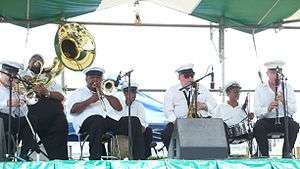
The tradition of brass bands in New Orleans, Louisiana dates to the late 19th and early 20th centuries. Traditionally, New Orleans brass bands could feature various instrumentations, often including trumpets, trombones, clarinets, saxophones, sousaphones, and percussion. The music played by these groups was often a fusion between European-styled military band music and African folk music brought to the Americas by West African slaves and the idiom played a significant role in the development of traditional jazz. Early brass bands include the Eureka Brass Band, the Onward Brass Band, the Excelsior Brass Band, the Tuxedo Brass Band, the Young Tuxedo Brass Band, the Camelia Brass Band, and the Olympia Brass Band.
The Treme Brass Band, while not as old, has members who have been influential throughout New Orleans Brass Band music, as well as being renowned in its own right.
A well-known use of these bands is for the New Orleans jazz funeral and second line parades.
Hip-Hop and Funk
In the 1970s and 1980s, the New Orleans brass band tradition experienced a renaissance, with bands breaking away from traditional stylings and adding elements of funk, hip hop, and bop to their repertoires. Some notable exponents of this style of brass band include the band Def Generation, members of the next generation of Nevilles who created hip hop over live brass bands influencing, Soul Rebels Brass Band, Rebirth Brass Band, the Stooges Brass Band, the Hot 8 Brass Band, the Lil Rascals Brass Band, Youngblood Brass Band, The Original Pinettes Brass Band, the Dirty Dozen Brass Band and The Big 6 Brass Band. Also, a number of groups outside the United States have begun playing this style of music.
The style of the music is often characterized by the use of the sousaphone in place of a Double bass to play the bass-line. The sousaphone may play a traditional jazz walking bass-line or groove on a riff. Trumpets, trombones, saxophones, and other horns play melodies and harmonies loosely over the bass-line. Often the lines are greatly embellished with improvisation. A typical setup includes two percussionists, one playing a marching bass drum and a cymbal mounted on the drum and another playing a snare drum (the snare drummer often switches to a drum kit when not marching). Many variations on this exist, including the use of additional percussionists, cymbals, drums, whistles and Scratch DJ's.
The style has moved beyond New Orleans and can now be found in such places as Japan with the Black Bottom Brass Band; Finland with TIMO Brass Band; Belgium with Brazzmatazz, the Netherlands with the Neutral Ground Brass Band, Happy Feet and the Hurricane brass bands; Scotland with the Criterion Brass Band; England with the Renegade Brass Band; Australia with the Horns of Leroy Brass Band; Phoenix, Arizona with the Bad Cactus Brass Band; Boston, Massachusetts with the Hot Tamale Brass Band; Hartford, CT with the Funky Dawgz Brass Band; Tennessee with Halfbrass; Minnesota with the Jack Brass Band and the Dirty Shorts Brass Band; Missouri with the Funky Butt Brass Band; Georgia with the Half Dozen Brass Band; Cincinnati, Ohio with The Cincy Brass; Madison, Wisconsin with the Mama Digdown's and Youngblood; Richmond, VA No BS! Brass brass bands; and Sacramento, California with Element Brass Band.
Polynesia
Founded in 1836 by King Kamehameha III, the Royal Hawaiian Band is the second oldest and only full-time municipal band in the United States. In recent generations, unique brass band traditions have also developed in Tonga, Samoa, and other parts of Polynesia, as well as among the Māori of New Zealand. Some recordings are now available and these styles are beginning to be researched and promoted abroad through band tours.
Zanzibar
Deriving from English 'band', Beni is a popular wedding entertainment with a strong focus on rhythm and dance, and audience participation. Beni originated in Zanzibar around the turn of the 20th century as a mockery of colonial style military bands.
In Zanzibar, Beni is performed both as a street parade and stationary as a wedding dance.
Festivals and contests
One festival featuring brass bands is the Tarragona International Dixieland Festival, in Catalonia, Spain. The organisation programs not only dixieland brass bands but also ethnic or world music brass bands from over the world, including the Dirty Dozen Brass Band from the US, Boban Marković Orkestar from Serbia, the Jaipur Kawa Brass Band from India and Taraf Goulamas from Occitania France.
In the United States the Great American Brass Band Festival has been held annually in Danville, Kentucky for the past 30 years and is free for all. This event attracts brass band lovers from the U.S., Canada, and Europe. The Vintage Band Festival occurs in Northfield, Minnesota every three years.[4][5]
The North American Brass Band Association[6] sponsors an annual convention that provides member bands with the opportunity to compete in a contest format similar to those conducted in the United Kingdom and Europe. The contest is typically late March to early April every year.
In Boston, Seattle and Austin a series of festivals called HONK! bring together street brass bands (and other related ensembles) from the United States and Canada, and some bands from other parts of the world. The groups presented include Balkan Brass Bands, New Orleans brass bands, Political Action Bands, Klezmer, and "DIY" Alternative / Radical Community Bands.
Lists
Brass bands
- Bestwood Welfare Black Diamonds Brass Band
- Black Dyke Band
- Brass Band Buizingen
- Brighouse and Rastrick Brass Band
- Carlton Main Frickley Colliery Band
- Central Park Brass
- Chalk Farm Band of the Salvation Army
- City of Oxford Silver Band
- Dublin Silver Band[7]
- Eastern Iowa Brass Band
- Foden's Band[8]
- Grimethorpe Colliery Band[9]
- Helston Town Band[10]
- Herb Alpert & the Tijuana Brass
- Hot 8 Brass Band
- Hungry March Band
- Hypnotic Brass Ensemble[11]
- International Staff Band of the Salvation Army
- Kaohsiung Jin-Zan Brass Band
- Lanner and District Silver Band
- Leyland Band
- Maidenhead Citadel Band of the Salvation Army
- Mama Digdown's Brass Band[12]
- Rebirth Brass Band[13]
- Reg Vardy Band
- River City Brass Band
- Rode Hall Silver Band
- Soul Rebels Brass Band[14]
- Stooges Brass Band[15]
- Tapton Youth Brass Band
- The City of Wolverhampton Brass Band
- The Dirty Dozen Brass Band[16]
- The Harrogate Band
- The Ohio State University Marching Band [17]
- The Original Pinettes Brass Band[18]
- To Be Continued Brass Band[19]
- Treme Brass Band
- Vernon Building Society (Poynton) Brass Band
- Virtuosi GUS Band
- Wellington Brass Band
- Worcester Concert Brass
- Youngblood Brass Band
- Yorkshire Imperial Band
Brass band composers
Brass band instrument manufacturers, historical and present
- Antoine Courtois
- Besson
- Boosey and Hawkes
- Boston Musical Instrument Company
- C.G. Conn, Ltd. (later Conn-Selmer)
- E.A. Couturier
- F.A. Reynolds
- F.E. Olds
- J. W. York
- Jupiter Band Instruments
- The Standard Band Instrument Company
- The Frank Holton Company
- The H.N. White Company (King Musical Instruments)
- The Martin Band Instrument Company
- Vincent Bach Corporation
- Vega Company
- Yamaha Musical Instruments
References
- Bradt Travel Guide Serbia - Laurence Mitchell - Google Böcker. Books.google.se. Retrieved 4 June 2014.
- "Writing For Brass Bands". Bandsman.co.uk. Retrieved 4 June 2014.
- "Welcome! - The International Staff Band". www.theisb.com. Retrieved 10 June 2017.
- "Vintage Band Festival". Vintage Band Festival. Retrieved 18 February 2018.
- "Great American Brass Band Festival - Great American Brass Band Festival". Great American Brass Band Festival. Retrieved 18 February 2018.
- "NABBA". www.nabba.org. Retrieved 10 June 2017.
- "Dublin Silver Band - Dublin Community Bands". Retrieved 10 June 2017.
- "Welcome to Foden's Band Website". www.fodensband.co.uk. Retrieved 10 June 2017.
- "Grimethorpe Band – The World's Most Famous Colliery Band". www.grimethorpeband.com. Retrieved 10 June 2017.
- "Helston Town Band". www.helstontownband.co.uk. Retrieved 10 June 2017.
- "hypnoticbrassensemble.com". www.hypnoticbrassensemble.com. Retrieved 10 June 2017.
- "Mama Digdown's Brass Band". www.mamadigdown.com/. Retrieved 16 June 2017.
- "Rebirth Brass Band - New Orleans Brass Bands". 20 November 2012. Retrieved 10 June 2017.
- "The Soul Rebels". thesoulrebels.com. Retrieved 10 June 2017.
- "Stooges Brass Band". stoogesbrassband.com/. Retrieved 16 June 2017.
- "The Dirty Dozen Brass Band". www.dirtydozenbrass.com/. Archived from the original on 15 June 2017. Retrieved 16 June 2017.
- "The Ohio State University Marching and Athletic Bands". The Ohio State University Marching and Athletic Bands. Retrieved 10 June 2017.
- "The Original Pinettes Brass Band - Home". www.originalpinettes.com. Retrieved 10 June 2017.
- "To Be Continued Brass Band". www.tbcbrass.com. Retrieved 16 June 2017.